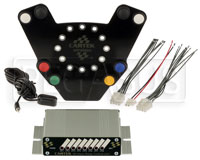| The Cartek Wireless Steering Wheel Controls puts pushbutton controls at your fingertips, right behind your racing steering wheel. It operates wirelessly, so you can use a quick-release hub without having to deal with cables or special connectors. |
What does the Cartek Wireless Steering Wheel Controls do?
Short version: It adds 8 wireless switches to your steering wheel. No drilling is needed if your wheel has the standard 6x70mm OMP/MOMO/Sparco or 6x74mm Nardi bolt pattern.
What's so special about it?
The switch panel is totally wireless. If you have a quick-release steering wheel hub, you don't have to deal with a cable hanging down. You also don't have to change over to a special "wired" quick-release hub with a special connector.
How does it work?
The switch plate houses a small, battery-operated infra-red (IR) transmitter. When you press a button on the switch plate, an IR signal is sent to the remote receiver. The receiver is wired to a relay box, which then connects or disconnects the desired circuit.
Why is the receiver separate from the relay box?
The receiver needs to have a clear line of sight to the transmitter. The relay box measures about 4 3/8" x 3 3/8" x 1 1/4", so Cartek provides a miniature remote receiver for ease of mounting. The receiver connects to the relay box by a 9 foot long cable. You can mount the relay box next to the driver, in the back seat, in the dashboard, or even in the trunk.
So what does it actually do?
Each of the 8 circuits can be programmed to operate in any of 5 different ways:
Momentary Contact: Hold the button down to make contact; let go to break it.
Latching: Press the button to make contact; press it a second time to break it.
Latching with Memory: Like Latching, except the on or off position is "remembered" when the car is turned off and recalled when the car is turned back on again.
Flashing: Press the button to make intermittent contact; let go to break it. Two flashing speeds are available.
Does it only turn things on and off? I'd like to use it for my radio.
The relay unit only makes and breaks contact -- it doesn't connect any circuit to power or to ground. That means it can handle any type of switching duty: Power switching (either +12v or ground) or signal switching such as push to talk. You can even use it to scroll your dash or reset your trip odometer (assuming your dash gives you those options).
What kind of power will it handle? Can I use it for the starter and ignition?
Each circuit can handle a maximum of 10 amps. You can use it to trigger an ignition relay or a starter solenoid. It can also trigger a headlight relay, horn relay, fan relay...
So, relays.
Relays are the key to happiness. That's not only true of the Cartek unit, that goes for just about any switch. Use the switch to control the relay, and the relay handles the high-amperage load that would burn out the switch.
Wait, go back to the dash scrolling. What?
Yeah, the new AiM MXL2, MXG, and MXS dash loggers let you control dash functions using remote switches! The Cartek Wireless Steering Wheel Controls is practically tailor-made for the job. Just add the AiM Remote Button Interface (Part No. MC-255) to your dash. Presto, the buttons are at your fingertips.
How hard is it to program?
Beyond easy.
To enter the programming routine, start with the car off. Press and hold the Mode button on the relay box while turning on the power to the box, then release the button. The Channel 1 LED will flash. The number of flashes indicates which mode it is in (1 = momemtary, 2 = latching, etc). Press the Set button to scroll through the modes. Press the Mode button again to move to the next channel. When you're done, turn the power off.
Oh no -- I should have put this one function on Button 2 instead of Button 4.
You can reprogram the unit so that Button 2 controls Circuit 4. No re-wiring needed!
To "move" a switch to a different channel, start with the car off. Press and hold the Set button on the relay box while turning on the power to the box, then release the button. The Channel 1 LED will flash. Press the switch you want assigned to Channel 1. When you do, programming will also automatically move on to the next channel. When you're done, turn the power off.
Note that only one button can be used to control each channel, and each button can only control one channel. You can't have buttons 1 and 3 controlling the same channel, and button 2 can't control channels 2 and 4.
OK, I really screwed it up. Can I start totally over?
"Start totally over" is also called a "full reset." Turn the power off, then press and hold both the Mode and the Set buttons while turning the power on. Release the buttons and all of the programming will be wiped from memory.
One circuit doesn't seem to work. How do I know where the problem is?
Each channel has its own LED on the front of the relay box. If the LED is on, that means the relay box is making the connection for that circuit.
Wow, is there anything the Cartek Wireless Steering Wheel Controls can't do?
It does not make good coffee.
No, seriously.
Basically, if you can control it with an external switch, the Cartek can switch it. Ignition, fuel pumps, starter, lights, wipers, fans, radio, horn, cool suit, lap timer, dash, pit lane speed limiter, gauge memory recall... what else have you got?
How about controlling a Cartek Battery Isolator?
OK, you caught me. That is one of the few things that would not work, and here's why: Cartek Battery Isolators use a momentary-break switch to turn them off. That means the circuit must be connected before the Isolator can turn on. But the Steering Wheel Controls can't connect the circuit until the relay box gets power, which means the Isolator would have to be on first. Catch-22.
More like a chicken-and-egg.
That reminds me, it will also not make breakfast.
How about adjusting fuel and ignition maps like they do in F1?
If your control system can adjust by a series of pulses (e.g., if 6 button pushes will "scroll" to Map 6), then yes. If it requires a rotary switch, then no.
Can I use it trigger my fire system?
We do not recommend this one for safety reasons. The Cartek Wireless Steering Wheel Controls can do it, but if you ever need the fire system when the car's electical system is off or disabled, the signal will not get to the fire system. (This is the same reason why most fire systems use their own power supply instead of relying of the car's electrical system.)
What else do I need to know?
The Cartek Wireless Steering Wheel Controls require a 9v to 15v DC power supply for the relay box. The switch panel runs on a small A23 size 12v battery.
I've never heard of an A23 battery. Is that European?
No, it's a common size for small electronics. (And in Europe it's actually called an MN21.) You might have one in a film camera or in your garage door remote.
Can I buy them from you?
We don't carry this type of battery because you can find them easily and cheaply. Mega-marts, every-corner drugstores, grocery stores, hardware stores, home supply stores, and office supply stores all carry them. Search A23 battery on Google and you'll see a lot of familiar names.
Wouldn't it be smart to carry a spare battery?
Sure, but don't expect to change the battery every weekend. The battery is only called on while you are actually pressing a button. As soon as you release the button, the switch panel completely stops using power.
Also, pressing a button on the switch plate makes a little LED on the back of the transmitter unit light up. Green means you're good to go, red means get ready to replace the battery. With the car turned off, remove the wheel and press a button to check the LED color. Add that to your pre-race checklist and you'll never have an unpleasant surprise.
Who is Cartek?
Cartek is a British company that has been designing and manufacturing electronic components for professional racing since 2002. Their products are found in international GT cars, Global Rallycross, formula cars, Australian V8 Supercars, and more. Some series even specify Cartek products as mandatory. Cartek products are trusted by such companies as Porsche, AMG Mercedes, and Ford.
Buy Cartek Automotive Electronics:
Cartek Wireless Steering Wheel Controls
This article was first published on 5/5/2016.
It was most recently modified on 5/9/2016.

